How to Use Sentiment Analysis to Strengthen SEO Trustworthiness

I made the case in my last post that a website’s online sentiment now affects search engine rankings.
That’s because Google evaluates a website’s quality based on three factors — expertise, authoritativeness, and trustworthiness (E-E-A-T).
Sentiment indicates reputation, which indicates trustworthiness. However, if the sentiment is negative, it can damage a reputation.
My belief is that the sentiment around a brand or website is its primary indicator of trustworthiness. This is why sentiment analysis is now part of SEO success.
To help you use sentiment analysis to strengthen your site, here I’ll explain how to do it both manually and with today’s best tools. In this post:
- What is sentiment
- What is sentiment analysis
- Why reviews are important
- Sentiment beyond online reviews
- How to conduct sentiment analysis (manually and with tools)
- How to incorporate sentiment data in SEO
- FAQ: How can I use sentiment analysis to improve my brand’s online reputation and trustworthiness?
What Is Sentiment?
By definition, sentiment is the emotional tone behind someone’s words, whether written or spoken. When it comes to your business, it’s what people are saying and feeling about your company and products.
Discovering your brand’s online sentiment has many benefits. You can use that kind of info to improve customer satisfaction, influence product development, expand brand awareness … the list goes on.
How do you discover your online sentiment? Through sentiment analysis.
What Is Sentiment Analysis?
Sentiment analysis is the process of analyzing text to determine the speaker or writer’s emotional tone.
Basically, it’s figuring out how the writer feels about the subject. This can be done with a few key searches or with sentiment analysis tools.
As humans, we are pretty good at understanding what people say as either positive, negative, or neutral. So, we analyze sentiment naturally.
Computers, on the other hand, have a much harder time with it. Consider these examples:
- “This place is terrific!”
- “This place is a terrific waste of money!”
We can tell the difference easily. But can a machine tell that these two comments have opposite sentiments? Thanks to artificial intelligence and machine learning, analyzing sentiment is now possible — and I believe Google is using sentiment measurement to detect that trust component.
When Google wants to analyze the sentiment of a brand or website, it mostly looks at online reviews.
Why Reviews Are Important
User reviews affect purchasing decisions. Online reviews signal trust and help increase the buyer’s confidence.
A study by Spiegel Research Center found that “The purchase likelihood for a product with five reviews is 270% greater than the purchase likelihood of a product with no reviews.” Interestingly, the study found that reviews carry twice as much weight for higher-priced products.
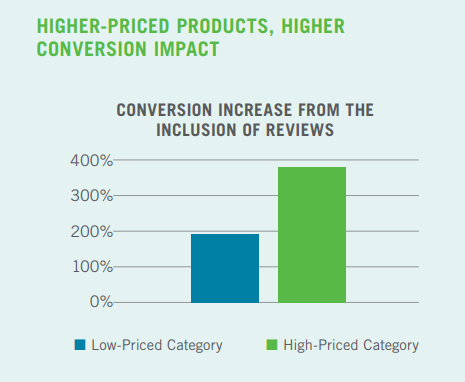
So, the bigger the purchase decision, the more people rely on reviews.
If online reviews influence people’s purchasing decisions this much, it’s no wonder search engines want to factor them into their algorithms.
Search engines want satisfied searchers. So, they need to show trustworthy results.
But review sites aren’t the only places to find user sentiment …
Sentiment Beyond Online Reviews
Social sentiment is all over the web. Customers are sharing how they feel about you on social media, in forums, in news articles, and in Wikipedia.
All that sentiment, so little time.
Reading all comments across every social media platform and review site is a lot of work. Even a small business will find that challenging.
Luckily, there are relatively pain-free ways to perform sentiment analysis — both with and without tools.
How to Conduct Sentiment Analysis
Now that we know it’s possible to analyze online sentiment, the question is: how do you mine and analyze online sentiment across multiple sites?
Using a combination of manual searches and sentiment analysis tools, you can get a pretty good understanding of a site’s online reputation and monitor it in real time.
First, I’ll show you how to run a sentiment analysis without tools.
How to Do Sentiment Analysis Manually
Tools are helpful when monitoring real-time reviews and conversations. But even without them, you can get an accurate understanding of a brand’s reputation online. Here’s how.
Step 1: Start with the Better Business Bureau.
The Better Business Bureau’s slogan is “Start with Trust.”
It is one of the most important metrics for a business’s reputation (for businesses within the U.S.).
Pay attention to your BBB rating and address complaints. You’d be surprised at the number of clients that don’t do either.
Step 2: Check independent rating services.
Besides the BBB, millions of people use Yelp, Consumer Reports, Amazon, and Google Shopping. Visit these sites and learn how people feel about you by reading the reviews.
It’s also a good idea to check smaller review sites that focus on your industry niche. BrightLocal has a great list of high-quality niche review sites for your reference. Many people rely on these specialized review sites when it comes to industries such as healthcare and law.
Step 3: Take advantage of your review accounts.
SEOs should make sure websites are making the most of the review sites and social media platforms they already have.
If you’re not doing so already, monitor and encourage Google reviews. Make sure your Google My Business account is current.
Also, turn on Reviews on your Facebook business page. Recommendations that people make on Facebook are integrated into reviews, so it is important to enable this feature and add greater trust.
Your Google reviews and ratings appear prominently in the knowledge panel when anyone searches for your brand. Facebook or other site’s reviews can also show up, so don’t miss out on these trust signals.
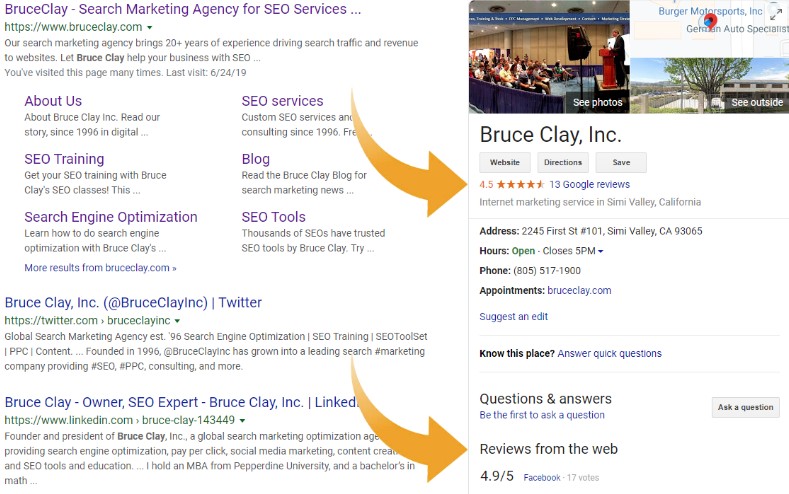
Step 4: Use the 100-Point Algorithm.
I am impressed with Brian Patterson’s metric for calculating a brand’s online reputation. Called the “100-Point Algorithm,” it calculates the sentiment score of a particular search results page. Brian is a columnist at Search Engine Land and he shared his equation back in 2015.
It’s a manual way to discover and track sentiment by page, and you can learn how to do it directly from him.
Now that you’ve done the hard work by hand, it’s time to see what the bots can do for you.
6 Tools for Sentiment Analysis
There are many sentiment analysis tools that offer different features and functionalities. Some only mine and analyze, while others also organize and display the data.
When choosing which tool is for you, consider the sources and features so that the tool complements your manual efforts.
Here, I review six sentiment analysis tools for SEOs:
- Yext
- Chatmeter
- BrightLocal
- Hootsuite Insights
- Social Mention
- Sentiment Analyzer
Yext
Yext recently added sentiment analysis to its Reviews monitoring software. A new Sentiment tab shows business owners what reviewers are saying as either positive or negative. It shows data based on keywords (like “place”) and their modifiers (like “great” or “bad”) used in reviews. Each word has a sentiment score assigned to it.
There’s also a way to create a collection of keywords (such as words related to “food”) to help the business understand how people feel by topic.
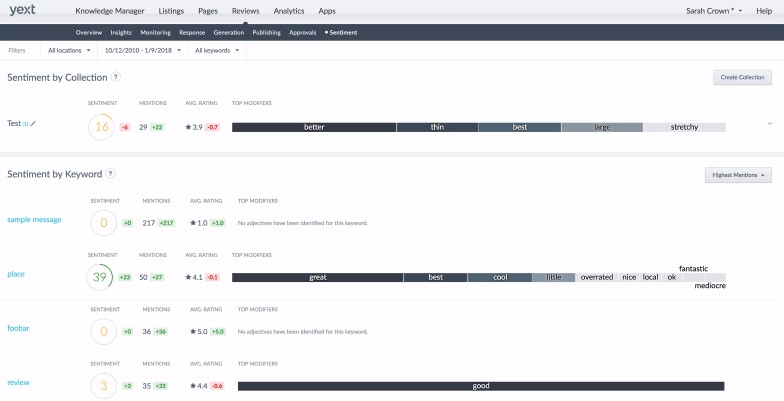
Chatmeter
Great for multi-location companies, Chatmeter Pulse is a text and sentiment analysis tool that shows sentiment analysis over time. One standout feature of Pulse is that it can recognize mixed sentiment within a single review and break down sentiment by topic.
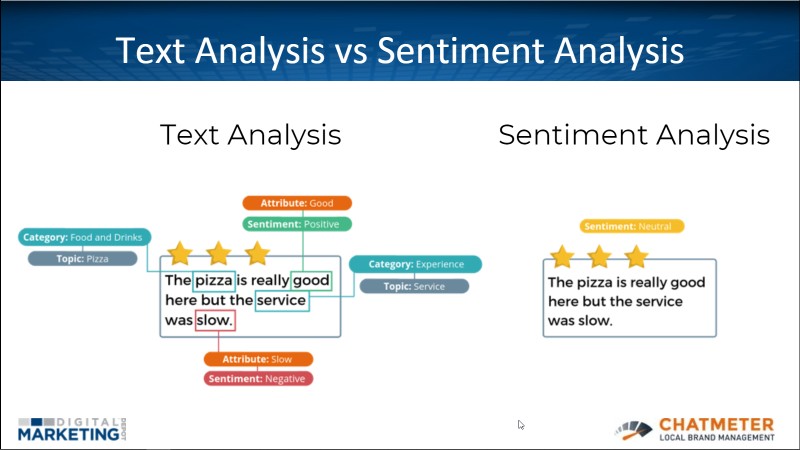
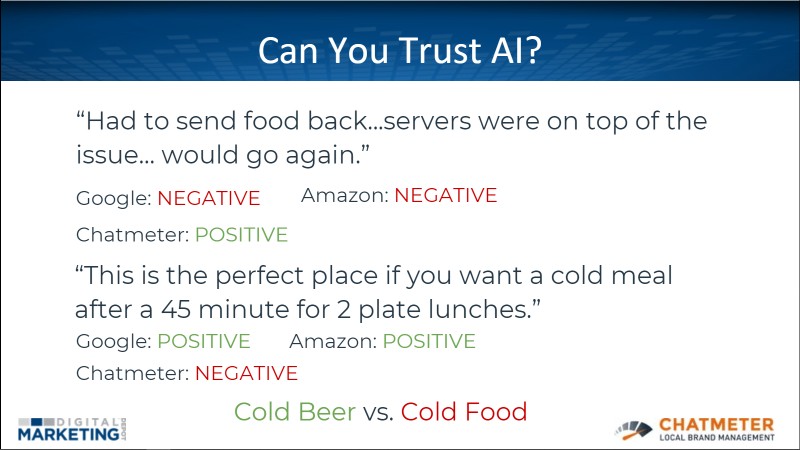
The sunburst tool helps you understand the average sentiment for each topic and its related attributes with color-coded segments. If you’re working with a multi-site client, the product can compare sentiment by location, too. You can run a free brand audit to learn more.
BrightLocal
The BrightLocal Reputation Manager lets you monitor and manage all your online reviews in one place. Users get to see and manage reviews by source and can use the tool to simplify the way customers write reviews.
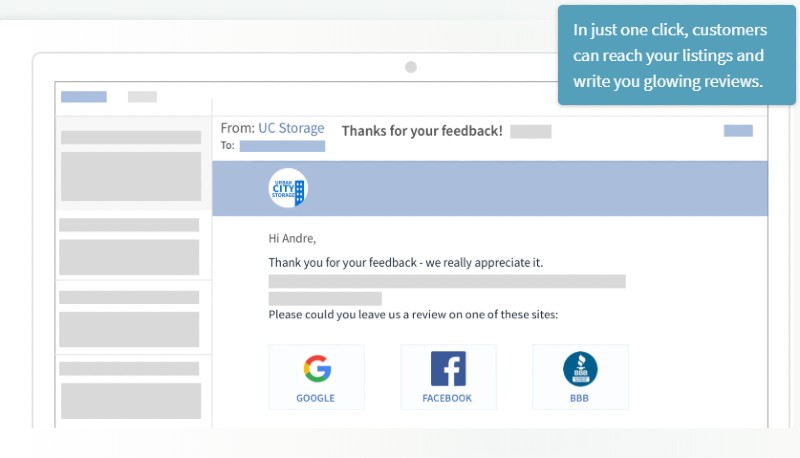
Most recently, Reputation Manager added 40 new niche review sites so that customers can now see and review data on more high-quality and relevant review sites. If you’re an agency or working with a multi-site client, the tool’s new Review Inbox feature is also a plus. It brings all reviews together in a single feed or dashboard.
Hootsuite Insights
A real-time social analytics tool, Hootsuite Insights lets you filter sentiment results by location, language, and gender. This tool goes beyond social media sites and mines sentiment from news sites, blogs, forums, and other public sources online (over 100 million) to produce results you can then use to run reports, stay on top of trends, and handle customer complaints before they backfire.
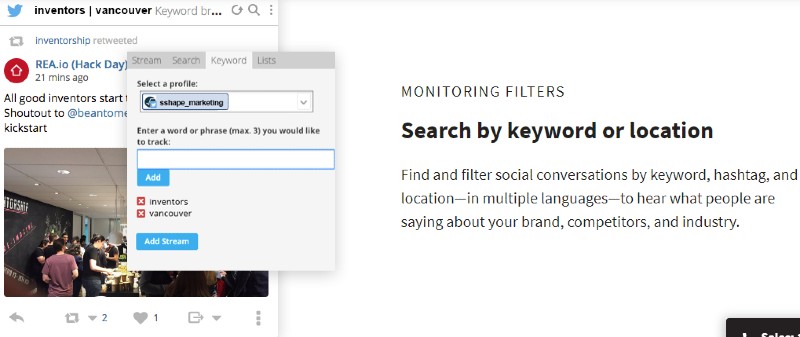
Social Mention
If you’re looking for a free social media analysis tool, Social Mention has a free option that allows up to 100 searches a day and two email alerts. Without the need to sign up or download anything, you can simply search for a brand or hashtag via a search engine to uncover real-time online sentiment. The report includes the number of mentions, users and a sentiment score with detailed analytics and a simple way to stay on top of everything that’s being said about your brand or keyword online.
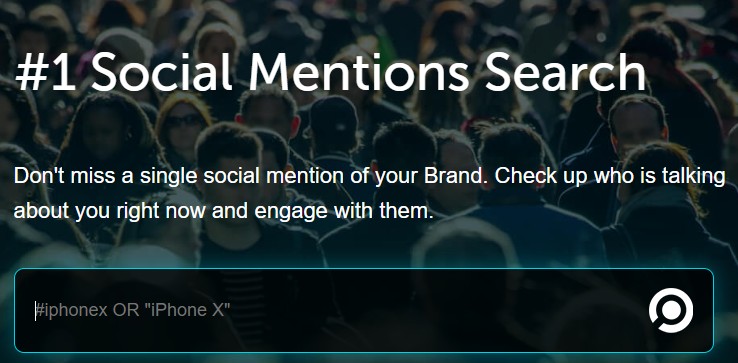
Sentiment Analyzer
Another free one, Sentiment Analyzer allows you to analyze a snippet of text and produces a sentiment score from –100 to +100. Unlike the other tools listed, it analyzes a body of text as opposed to mentions of a brand or hashtag online.
Use this tool if you want a better way to decipher vague or confusing customer reviews. The example shown on the tool’s homepage is the Declaration of Independence, which, according to the tool, has a sentiment score of 26.8, indicating that the text is “somewhat positive/enthusiastic.”
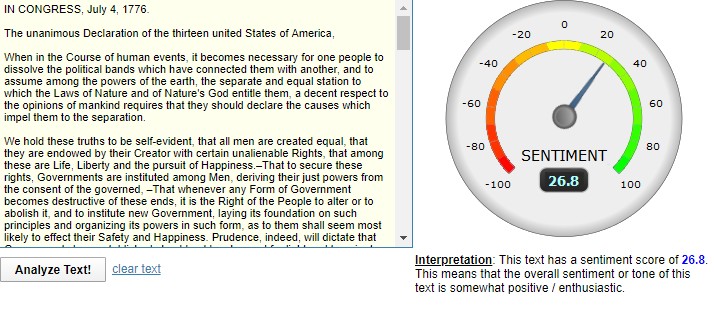
How to Incorporate Sentiment Data in SEO
Now that I’ve explained HOW to analyze your brand’s sentiment let’s discuss what to do with it.
We use sentiment analysis to enhance our audits. We also use it to track the success of campaigns and spot potential issues.
Some customers have trust issues with a brand or website, and it’s our job as SEOs to discover why.
Analyzing sentiment can identify reputation problems and help a company develop a more customer-centric approach that:
- Addresses customer complaints
- Resolves satisfaction issues
- Rewards happy reviewers
- Reinforces the brand’s reputation and trustworthiness
More than a Feeling: A Trustworthy Site
As SEOs, we know when something’s just not right with a website.
We dig, we dig deeper, and often times we discover that it comes down to how a website or brand interacts with its customers.
Customers are real people with feelings. Feelings matter, and how we handle them does, too.
Make sentiment analysis part of your SEO toolkit, and you’ll lay the foundation for a trustworthy site.
As I mentioned in my first post, we now include sentiment analysis as part of our SEO audits. If you’d like to learn more about how to improve your online presence, request a free quote today.
FAQ: How can I use sentiment analysis to improve my brand’s online reputation and trustworthiness?
Maintaining a positive online reputation is crucial for any brand. Consumers today are not just looking for products or services; they’re seeking trust and reliability. This is where sentiment analysis comes into play.
Understanding Sentiment Analysis
Sentiment analysis, also known as opinion mining, systematically determines the sentiment expressed in online content, whether positive, negative, or neutral. Brands can utilize sentiment analysis to gain valuable insights into customers’ perceptions. By comprehending the emotions behind customer feedback, brands can respond effectively and make informed decisions to enhance their reputation.
Real-Time Monitoring
Sentiment analysis provides instantaneous insights for brands. Brands can monitor comments and mentions across multiple online platforms, including social media, forums, review sites, and other review platforms. By staying informed about what customers say in real-time, brands can swiftly address issues, offer solutions, and express gratitude for the positive feedback.
Enhancing Customer Experience
Sentiment analysis can identify recurring issues or trends in customer feedback. By addressing these pain points, brands can improve their products or services, resulting in a better customer experience. This proactive approach shows that you value your customers’ opinions and helps build trust and loyalty.
Leveraging Positive Sentiment
While addressing negative sentiment is essential, leveraging positive sentiment is equally powerful. When customers express satisfaction or appreciation, acknowledge and share their feedback on your platforms. This showcases your brand’s commitment to excellence and encourages more positive feedback.
Step-by-Step Procedure: Enhancing Your Brand’s Reputation with Sentiment Analysis
- Define Your Objectives: Clearly outline what you aim to achieve with sentiment analysis, whether improving customer satisfaction, resolving issues, or building trust.
- Select the Right Tools: Choose sentiment analysis tools that suit your brand’s needs and budget.
- Identify Relevant Platforms: Determine where your target audience is most active online and focus your sentiment analysis efforts there.
- Create a Keyword List: Develop a list of keywords and phrases related to your brand, products, or services to monitor sentiment effectively.
- Set Alerts: Real-time notifications can alert you to any mentions or mentions about your brand that might arise on social media so that any mentions can be addressed quickly and appropriately.
- Assess and Categorize Sentiment: Evaluate each comment or mention and categorize it as positive, neutral, or negative.
- Address Negative Sentiment: Respond to negative comments or reviews with empathy and solutions.
- Acknowledge Positive Sentiment: Show appreciation for positive feedback and consider sharing it on your platforms.
- Identify Trends: Analyze sentiment data to identify recurring issues or trends that require attention.
- Improve Products/Services: Use sentiment analysis insights to enhance your offerings and address customer concerns.
- Monitor Competitors: Extend your sentiment analysis to monitor how your competitors are perceived and identify areas where your brand can excel.
- Educate Your Team: Ensure your team is trained to interpret sentiment analysis data and respond effectively.
- Measure Progress: Continuously assess the impact of your sentiment analysis efforts on your brand’s reputation and trustworthiness.
- Adjust Your Strategy: Adapt your strategy based on the evolving sentiment trends and customer feedback.
- Engage with Customers: Engage with your audience through social media, forums, and review sites to maintain an open line of communication.
- Share Success Stories: Share stories of how you’ve addressed customer concerns and improved your offerings.
- Collect Feedback: Encourage customers to provide feedback directly, helping you gather valuable insights.
- Consistency is key to success.
- Assess Return On Investment (ROI): Evaluate the return on your investment for sentiment analysis efforts and verify if they support your brand goals.
- Adapt and Grow: Continuously adapt your sentiment analysis strategy to evolving consumer preferences and industry trends.
Follow these steps to leverage the power and potential of sentiment analysis to build trust among your audience, improve your brand’s online reputation, and elevate its image.
26,000+ professionals, marketers and SEOs read the Bruce Clay Blog
Subscribe now for free to get:
- Expert SEO insights from the "Father of SEO."
- Proven SEO strategies to optimize website performance.
- SEO advice to earn more website traffic, higher search ranking and increased revenue.

9 Replies to “How to Use Sentiment Analysis to Strengthen SEO Trustworthiness”
I am really enjoying reading your well written articles. It looks like you spend a lot of effort and time on your blog. I have bookmarked it and I am looking forward to reading new articles. Keep up the good work.
It is interesting to learn how reviews and social mentions can have a positive impact on SEO efforts and build more trust. I knew about the bright local tool before. But you have given us great insights about using such tools for sentimental analysis. Thanks for sharing this content.
Nice to read your blog. I was looking for negative sentiment keywords. I referred the blog but didn’t find andy suitable example here; so ki ndly suggest the suitable one
This article really explains a good concept of sentiment analysis which really helps for seo. Thanks for sharing
That’s a really fantastic guide. I’m going to have to bookmark it and come back again.
I have read your article and found very important information related to sentiment analysis.
Great post, Bruce, thank you very much! Informative and extremely useful, as always.
I have a question, though. For the cases of, say, media outlets or public figures (specially politicians and members of the judiciary), who are often mentioned in the context of negative public sentiment (i.e. a news story about a shooting or public statements about negative events that need to be taken care of)…
How does Google adjust AI analysis to these cases? Does it considers that media outlets often report negative news but still the public sentiment towards them could stay positive/neutral? Same case for public figures like elected officials or prosecutors, judges, etc. Or could there be a sort of “karma effect” that falls over media companies, public figures and institutions, because of the nature of the information they provide?
Warm regards.
Human sentiment matters a lot while surfing on the internet. Reviews can help you a lot while taking your business online.
LEAVE A REPLY









